Solved Problem on Kirchhoff's Laws
advertisement
In the circuit below find the currents in the branches and their directions.
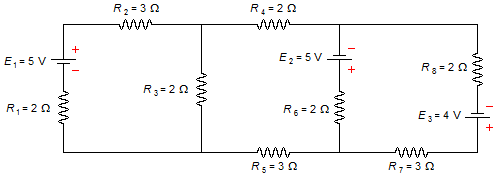
Problem Data:
Resistors:
- R1 = 2 Ω;
- R2 = 3 Ω;
- R3 = 2 Ω;
- R4 = 2 Ω;
- R5 = 3 Ω;
- R6 = 2 Ω;
- R7 = 3 Ω;
- R8 = 2 Ω;
- E1 = 5 V;
- E2 = 5 V;
- E3 = 4 V;
First, to each branch of the circuit, we randomly choose a direction of the current. In the branch GHAB we have the current i1 clockwise, in the branch BC the current i3 going from B to C, in the branch CDEF the current i4 clockwise, in the branch CF the current i5 going from C to F, in the branch FG the current i6 going from F to G and in the branch BG the current i3 going from B to G. Second for each loop we randomly assign a direction to traverse the mesh. α-mesh (GHABG), β-mesh (BCFGB), and γ-mesh (CDEFC) all clockwise (Figure 1).
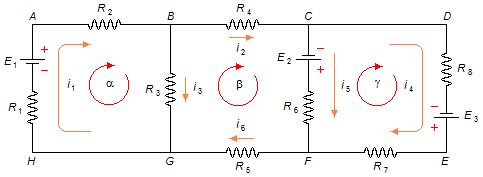
- Applying Kirchhoff's First Law
\[
\begin{gather}
\bbox[#99CCFF,10px]
{\sum_{n} i_{n}=0}
\end{gather}
\]
The current i1 flows into node B and currents i2, and
i3 flow out
\[
\begin{gather}
i_{1}=i_{2}+i_{3}\\[5pt]
i_{1}-i_{2}-i_{3}=0 \tag{I}
\end{gather}
\]
The current i2 flows into the nodeC and currents i4, and
i5 flow out
\[
\begin{gather}
i_{2}=i_{4}+i_{5}\\[5pt]
i_{2}-i_{4}-i_{5}=0 \tag{II}
\end{gather}
\]
The currents i4, and i5 flow into the node F and current
i6 flows out
\[
\begin{gather}
i_{6}=i_{4}+i_{5} \\[5pt]
i_{4}+i_{5}-i_{6}=0 \tag{III}
\end{gather}
\]
- Using Kirchhoff's Second Law
\[
\begin{gather}
\bbox[#99CCFF,10px]
{\sum_{n} V_{n}=0}
\end{gather}
\]
For the α-mesh from point A in the chosen direction, forgetting the meshes β e γ
(Figure 2)
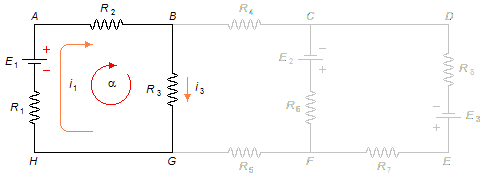
\[
\begin{gather}
R_{2}i_{1}+R_{3}i_{3}+R_{1}i_{1}-E_{1}=0
\end{gather}
\]
substituting the problem values
\[
\begin{gather}
3i_{1}+2i_{3}+2i_{1}-5=0\\[5pt]
5i_{1}+2i_{3}=5 \tag{IV}
\end{gather}
\]
For the β-mesh from point B in the chosen direction, forgetting the meshes α e γ
(Figure 3)
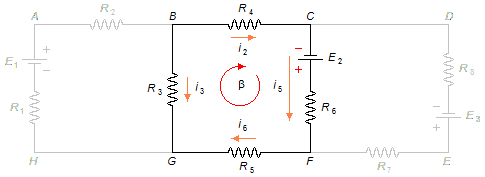
\[
\begin{gather}
R_{4}i_{2}-E_{2}+R_{6}i_{5}+R_{5}i_{6}-R_{3}i_{3}=0
\end{gather}
\]
substituting the values
\[
\begin{gather}
2i_{2}-5+2i_{5}+3i_{6}-2i_{3}=0\\[5pt]
2i_{2}-2i_{3}+2i_{5}+3i_{6}=5 \tag{V}
\end{gather}
\]
For the γ-mesh from point C in the chosen direction, forgetting the meshes α e β
(Figure 4)
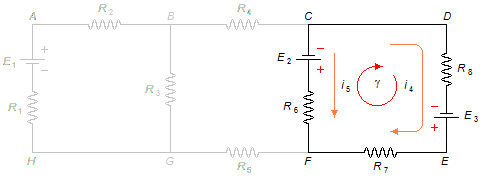
\[
\begin{gather}
R_{8}i_{4}-E_{3}+R_{7}i_{4}-R_{6}i_{5}+E_{2}=0
\end{gather}
\]
substituting the values
\[
\begin{gather}
2i_{4}-4+3i_{4}-2i_{5}+5=0\\[5pt]
5i_{4}-2i_{5}+1=0 \\[5pt]
5i_{4}-2i_{5}=-1 \tag{VI}
\end{gather}
\]
With equations (I), (II), (III), (IV), (V) and (VI) we have a system of six equations with six variables
( i1, i2, i3, i4,
i5, and i6 )
\[
\left\{
\begin{array}{l}
\;5i_{1}+2i_{3}=5\\
\;2i_{2}-2i_{3}+2i_{5}+3i_{6}=5\\
\;5i_{4}-2i_{5}=-1\\
\;i_{1}-i_{2}-i_{3}=0\\
\;i_{2}-i_{4}-i_{5}=0\\
\;i_{4}+i_{5}-i_{6}=0
\end{array}
\right. \tag{VII}
\]
writing the system as
\[
\left\{
\begin{array}{l}
\;5i_{1}+0i_{2}+2i_{3}+0i_{4}+0i_{5}+0i_{6}=5\\
\;0i_{1}+2i_{2}-2i_{3}+0i_{4}+2i_{5}+3i_{6}=5\\
\;0i_{1}+0i_{2}+0i_{3}+5i_{4}-2i_{5}+0i_{6}=-1\\
\;1i_{1}-1i_{2}-1i_{3}+0i_{4}+0i_{5}+0i_{6}=0\\
\;0i_{1}+1i_{2}+0i_{3}-1i_{4}-1i_{5}+0i_{6}=0\\
\;0i_{1}+0i_{2}+0i_{3}+1i_{4}+1i_{5}-1i_{6}=0
\end{array}
\right.
\]
this system can be represented by the following matrix, where the values on the left side of the dotted
line represent the matrix of the coefficients and the values on the right side represent the vector of
constants, this matrix is called the augmented matrix.
\[
\left(
\begin{matrix}
\;5& 0& 2& 0& 0& 0\;& \vdots& 5\;\\
\;0& 2& -2& 0& 2& 3\;& \vdots& 5\;\\
\;0& 0& 0& 5& -2& 0\;& \vdots& -1\;\\
\;1& -1& -1& 0& 0& 0\;& \vdots& 0\;\\
\;0& 1& 0& -1& -1& 0\;& \vdots& 0\;\\
\;0& 0& 0& 1& 1& -1\;& \vdots& 0\;
\end{matrix}
\right)
\]
To solve the system we use the Gaussian Elimination.
Note: The Gaussian Elimination for solving systems of linear equations consists to
perform elementary row operations to obtain an upper triangular matrix, then using back-substitution we
can find each unknown. To perform elementary operations on the rows of a matrix we can swap the position
of two rows, multiply an entire row by a non-zero scalar, and add one row to a multiple of another. An
upper triangular matrix is one where the entries below the main diagonal are zero.
For element a41=1 to be zero let's divide the 1st row by -5 and add the 4th row and substitute in the 4th row \( \left(\;\frac{R_{1}}{-5}+R_{4}\;\rightarrow \;R_{4}\;\right) \)
\[
\left(
\begin{matrix}
\;5& 0& 2& 0& 0& 0\;& \vdots& 5\;\\
\;0& 2& -2& 0& 2& 3\;& \vdots& 5\;\\
\;0& 0& 0& 5& -2& 0\;& \vdots& -1\;\\
\;1& -1& -1& 0& 0& 0\;& \vdots& 0\;\\
\;0& 1& 0& -1& -1& 0\;& \vdots& 0\;\\
\;0& 0& 0& 1& 1& -1\;& \vdots& 0\;
\end{matrix}
\right)
\qquad\frac{R_{1}}{-5}+R_{4}\rightarrow R_{4}
\]
-
\( a_{41}=\frac{5}{-5}+1=-1+1=0 \)
\( a_{41}=\frac{5}{-5}+1=-1+1=0 \)
-
\( a_{42}=\frac{0}{-5}+(-1)=0-1=-1 \)
\( a_{42}=\frac{0}{-5}+(-1)=0-1=-1 \)
-
\( a_{43}=\frac{2}{-5}+(-1)=-{\frac{2}{5}}-1 \)
, multiplying the numerator and the denominator of the last term by 5,
\( a_{43}=-{\frac{2}{5}}-1\times \frac{5}{5}=-{\frac{2}{5}}-\frac{5}{5}=-\frac{7}{5} \)
\( a_{43}=\frac{2}{-5}+(-1)=-{\frac{2}{5}}-1 \), multiplying the numerator and the denominator of the last term by 5, \( a_{43}=-{\frac{2}{5}}-1\times\frac{5}{5}=-{\frac{2}{5}}-\frac{5}{5}=-\frac{7}{5} \)
- \( a_{44}=\frac{0}{-5}+0=0 \)
- \( a_{45}=\frac{0}{-5}+0=0 \)
- \( a_{46}=\frac{0}{-5}+0=0 \)
- \( v_{4}=\frac{5}{-5}+0=-1 \)
\[
\left(
\begin{matrix}
\;5& 0& 2& 0& 0& 0\;& \vdots& 5\;\\
\;0& 2& -2& 0& 2& 3\;& \vdots& 5\;\\
\;0& 0& 0& 5& -2& 0\;& \vdots& -1\;\\
\;0& -1& -{\frac{7}{5}}& 0& 0& 0\;& \vdots& -1\;\\
\;0& 1& 0& -1& -1& 0\;& \vdots& 0\;\\
\;0& 0& 0& 1& 1& -1\;& \vdots& 0\;
\end{matrix}
\right)
\]
For element a42=−1 to be zero let's divide the 2nd row by 2 and add to the 4th row and
substitute in the 4th row.
\( \left(\;\frac{R_{2}}{2}+R_{4}\rightarrow R_{4}\;\right) \).For element a52=1 to be zero let's divide the 2nd row by -2 and add to the 5th row and substitute in the 5th row \( \left(\;\frac{R_{2}}{-2}+R_{5}\rightarrow R_{5}\;\right) \).
\[
\left(
\begin{matrix}
\;5& 0& 2& 0& 0& 0\;& \vdots& 5\;\\
\;0& 2& -2& 0& 2& 3\;& \vdots& 5\;\\
\;0& 0& 0& 5& -2& 0\;& \vdots& -1\;\\
\;0& -1& -{\frac{7}{5}}& 0& 0& 0\;& \vdots& -1\;\\
\;0& 1& 0& -1& -1& 0\;& \vdots& 0\;\\
\;0& 0& 0& 1& 1& -1\;& \vdots& 0\;
\end{matrix}
\right)
\begin{matrix}
\qquad\frac{R_{2}}{2}+R_{4}\rightarrow R_{4}\\
\qquad\frac{R_{2}}{-2}+R_{5}\rightarrow R_{5}
\end{matrix}
\]
- \( a_{41}=\frac{0}{2}+0=0 \)
-
\( a_{42}=\frac{2}{2}+(-1)=1-1=0 \)
\( a_{42}=\frac{2}{2}+(-1)=1-1=0 \)
-
\( a_{43}=\frac{-2}{2}+\left(-{\frac{7}{5}}\right)=-1-\frac{7}{5} \)
, multiplying the numerator and the denominator of the first term by 5,
\( a_{43}=-1\times \frac{5}{5}-\frac{7}{5}=-\frac{5}{5}-\frac{7}{5}=-\frac{12}{5} \)
\( a_{43}=\frac{-2}{2}+\left(-{\frac{7}{5}}\right)=-1-\frac{7}{5} \), multiplying the numerator and the denominator of the first term by 5, \( a_{43}=-1\times \frac{5}{5}-\frac{7}{5}=\frac{-{5}}{5}-\frac{7}{5}=\frac{-{12}}{5} \)
- \( a_{44}=\frac{0}{2}+0=0 \)
- \( a_{45}=\frac{2}{2}+0=1 \)
- \( a_{46}=\frac{3}{2}+0=\frac{3}{2} \)
-
\( v_{4}=\frac{5}{2}+(-1)=\frac{5}{2}-1 \)
, multiplying the numerator and the denominator of the last term by 2,
\( v_{4}=\frac{5}{2}-1\times \frac{2}{2}=\frac{5}{2}-\frac{2}{2}=\frac{3}{2} \)
\( v_{4}=\frac{5}{2}+(-1)=\frac{5}{2}-1 \), multiplying the numerator and the denominator of the last term by 2, \( v_{4}=\frac{5}{2}-1\times \frac{2}{2}=\frac{5}{2}-\frac{2}{2}=\frac{3}{2} \)
- \( a_{51}=\frac{0}{-2}+0=0 \)
-
\( a_{52}=\frac{2}{-2}+1=-1+1=0 \)
\( a_{52}=\frac{2}{-2}+1=-1+1=0 \)
- \( a_{53}=\frac{-2}{-2}+0=1 \)
- \( a_{54}=\frac{0}{-2}+(-1)=-1 \)
-
\( a_{55}=\frac{2}{-2}+(-1)=-1-1=-2 \)
\( a_{55}=\frac{2}{-2}+(-1)=-1-1=-2 \)
- \( a_{56}=\frac{3}{-2}+0=-\frac{3}{2} \)
- \( v_{5}=\frac{5}{-2}+0=-\frac{5}{2} \)
\[
\left(
\begin{matrix}
\;5& 0& 2& 0& 0& 0\;& \vdots& 5\;\\
\;0& 2& -2& 0& 2& 3\;& \vdots& 5\;\\
\;0& 0& 0& 5& -2& 0\;& \vdots& -1\;\\
\;0& 0& -{\frac{12}{5}}& 0& 1& \frac{3}{2}\;& \vdots& \frac{3}{2}\;\\
\;0& 0& 1& -1& -2& -{\frac{3}{2}}\;& \vdots& -{\frac{5}{2}}\;\\
\;0& 0& 0& 1& 1& -1\;& \vdots& 0\;
\end{matrix}
\right)
\]
For the element
\( a_{53}=1 \)
to be zero let's swap the rows 3 and 5
\( \left(\;R_{3}\leftrightarrow R_{5}\;\right) \)
\[
\left(
\begin{matrix}
\;5& 0& 2& 0& 0& 0\;& \vdots& 5\;\\
\;0& 2& -2& 0& 2& 3\;& \vdots& 5\;\\
\;0& 0& 0& 5& -2& 0\;& \vdots& -1\;\\
\;0& 0& -{\frac{12}{5}}& 0& 1& \frac{3}{2}\;& \vdots& \frac{3}{2}\;\\
\;0& 0& 1& -1& -2& -{\frac{3}{2}}\;& \vdots& -{\frac{5}{2}}\;\\
\;0& 0& 0& 1& 1& -1\;& \vdots& 0\;
\end{matrix}
\right)
\qquad R_{3}\leftrightarrow R_{5}\\
\]
\[
\left(
\begin{matrix}
\;5& 0& 2& 0& 0& 0\;& \vdots& 5\;\\
\;0& 2& -2& 0& 2& 3\;& \vdots& 5\;\\
\;0& 0& 1& -1& -2& -{\frac{3}{2}}\;& \vdots& -{\frac{5}{2}}\;\\
\;0& 0& -{\frac{12}{5}}& 0& 1& \frac{3}{2}\;& \vdots& \frac{3}{2}\;\\
\;0& 0& 0& 5& -2& 0\;& \vdots& -1\;\\
\;0& 0& 0& 1& 1& -1\;& \vdots& 0\;
\end{matrix}
\right)
\]
For the element
\( a_{43}=-{\frac{12}{5}} \)
to be zero let's multiply the 3rd row by
\( \frac{12}{5} \)
and add the 4th row and substitute in the 4th row
\( \left(\;\frac{12}{5} \times R_{3}+R_{4}\rightarrow R_{4}\;\right) \)
\[
\left(
\begin{matrix}
\;5& 0& 2& 0& 0& 0\;& \vdots& 5\;\\
\;0& 2& -2& 0& 2& 3\;& \vdots& 5\;\\
\;0& 0& 1& -1& -2& -{\frac{3}{2}}\;& \vdots& -{\frac{5}{2}}\;\\
\;0& 0& -{\frac{12}{5}}& 0& 1& \frac{3}{2}\;& \vdots& \frac{3}{2}\;\\
\;0& 0& 0& 5& -2& 0\;& \vdots& -1\;\\
\;0& 0& 0& 1& 1& -1\;& \vdots& 0\;
\end{matrix}
\right)
\qquad\frac{12}{5} \times R_{3}+R_{4}\rightarrow R_{4}
\]
- \( a_{41}=\frac{12}{5}.0+0=0 \)
- \( a_{42}=\frac{12}{5}.0+0=0 \)
-
\( a_{43}=\frac{12}{5}.1+(-{\frac{12}{5}})=\frac{12}{5}-{\frac{12}{5}}=0 \)
\( a_{43}=\frac{12}{5}.1+(-{\frac{12}{5}})=\frac{12}{5}-{\frac{12}{5}}=0 \)
-
\( a_{44}=\frac{12}{5}.(-1)+0=-{\frac{12}{5}} \)
\( a_{44}=\frac{12}{5}.(-1)+0=-{\frac{12}{5}} \)
-
\( a_{45}=\frac{12}{5}\times (-2)+1=-{\frac{24}{5}}+1 \)
, multiplying the numerator and the denominator of the last term by 5,
\( a_{45}=-{\frac{24}{5}}+1\times \frac{5}{5}=-{\frac{24}{5}}+\frac{5}{5}=-{\frac{19}{5}} \)
\( a_{45}=\frac{12}{5}\times (-2)+1=-{\frac{24}{5}}+1 \), multiplying the numerator and the denominator of the last term by 5, \( a_{45}=-{\frac{24}{5}}+1\times \frac{5}{5}=-{\frac{24}{5}}+\frac{5}{5}=-{\frac{19}{5}} \)
-
\( a_{46}=\frac{\cancelto{6}{12}}{5}\times \left(\;-\frac{3}{\cancelto{1}{2}}\;\right)+\frac{3}{2}=-{\frac{6}{5}}\times \frac{3}{1}+\frac{3}{2}=-{\frac{18}{5}+\frac{3}{2}} \)
, the least commom multiple betweem 5 and 2 is 10,
\( a_{46}=\frac{-18\times 2+5\times 3}{10}=\frac{-36+15}{10}=-{\frac{21}{10}} \)
\( a_{46}=\frac{\cancelto{6}{12}}{5}\times \left(\;-\frac{3}{\cancelto{1}{2}}\;\right)+\frac{3}{2}=-{\frac{6}{5}}\times \frac{3}{1}+\frac{3}{2}=-{\frac{18}{5}+\frac{3}{2}} \), the least commom multiple betweem 5 and 2 is 10, \( a_{46}=\frac{-18\times 2+5\times 3}{10}=\frac{-36+15}{10}=-{\frac{21}{10}} \)
-
\( v_{5}=\frac{\cancelto{6}{12}}{\cancel{5}}\times \left(\;-{\frac{\cancel{5}}{\cancelto{1}{2}}}\;\right)+\frac{3}{2}=-{\frac{6}{1}}+\frac{3}{2} \)
, multiplying the numerator and the denominator of the firs term by 2,
\( v_{5}=-{\frac{6}{1}}\times \frac{2}{2}+\frac{3}{2}=-{\frac{12}{2}}+\frac{3}{2}=-{\frac{9}{2}} \)
\( v_{5}=\frac{\cancelto{6}{12}}{\cancel{5}}\times \left(\;-{\frac{\cancel{5}}{\cancelto{1}{2}}}\;\right)+\frac{3}{2}=-{\frac{6}{1}}+\frac{3}{2} \), multiplying the numerator and the denominator of the firs term by 2, \( v_{5}=-{\frac{6}{1}}\times \frac{2}{2}+\frac{3}{2}=-{\frac{12}{2}}+\frac{3}{2}=-{\frac{9}{2}} \)
\[
\left(
\begin{matrix}
\;5& 0& 2& 0& 0& 0\;&\vdots& 5\;\\
\;0& 2& -2& 0& 2& 3\;&\vdots& 5\;\\
\;0& 0& 1& -1& -2& -{\frac{3}{2}}\;&\vdots& -{\frac{5}{2}}\;\\
\;0& 0& 0& -{\frac{12}{5}}& -{\frac{19}{5}}& -{\frac{21}{10}}\;&\vdots& -{\frac{9}{2}}\;\\
\;0& 0& 0& 5& -2& 0\;&\vdots& -1\;\\
\;0& 0& 0& 1& 1& -1\;&\vdots& 0\;
\end{matrix}
\right)
\]
Swapping rows 4 and 5
\( \left(\;R_{4}\leftrightarrow R_{5}\;\right) \)
\[
\left(
\begin{matrix}
\;5& 0& 2& 0& 0& 0\;&\vdots& 5\;\\
\;0& 2& -2& 0& 2& 3\;&\vdots& 5\;\\
\;0& 0& 1& -1& -2& -{\frac{3}{2}}\;&\vdots& -{\frac{5}{2}}\;\\
\;0& 0& 0& -{\frac{12}{5}}& -{\frac{19}{5}}& -{\frac{21}{10}}\;&\vdots& -{\frac{9}{2}}\;\\
\;0& 0& 0& 5& -2& 0\;&\vdots& -1\;\\
\;0& 0& 0& 1& 1& -1\;&\vdots& 0\;
\end{matrix}
\right)
\qquad R_{4}\leftrightarrow R_{5}\\
\]
\[
\left(
\begin{matrix}
\;5& 0& 2& 0& 0& 0\;&\vdots& 5\;\\
\;0& 2& -2& 0& 2& 3\;&\vdots& 5\;\\
\;0& 0& 1& -1& -2& -{\frac{3}{2}}\;&\vdots& -{\frac{5}{2}}\;\\
\;0& 0& 0& 5& -2& 0\;&\vdots& -1\;\\
\;0& 0& 0& -{\frac{12}{5}}& -{\frac{19}{5}}& -{\frac{21}{10}}\;&\vdots& -{\frac{9}{2}}\;\\
\;0& 0& 0& 1& 1& -1\;&\vdots& 0\;
\end{matrix}
\right)
\]
For the element
\( a_{54}=-\frac{12}{5} \)
to be zero, we will multiply the 4th row by
\( \frac{12}{25} \)
and add to the 5th row and substitute in the 5th row
\( \left(\;\frac{12}{25} \times R_{4}+R_{5}\rightarrow R_{5}\;\right) \).For element a64=1 to be zero, let's divide the 4th row by -5, and add to the 6th row and substitute in the 6th row \( \left(\;\frac{R_{4}}{-5}+R_{6}\rightarrow R_{6}\;\right) \)
\[
\left(
\begin{matrix}
\;5& 0& 2& 0& 0& 0\;&\vdots& 5\;\\
\;0& 2& -2& 0& 2& 3\;&\vdots& 5\;\\
\;0& 0& 1& -1& -2& -{\frac{3}{2}}\;&\vdots& -{\frac{5}{2}}\;\\
\;0& 0& 0& 5& -2& 0\;&\vdots& -1\;\\
\;0& 0& 0& -{\frac{12}{5}}& -{\frac{19}{5}}& -{\frac{21}{10}}\;&\vdots& -{\frac{9}{2}}\;\\
\;0& 0& 0& 1& 1& -1\;&\vdots& 0\;
\end{matrix}
\right)
\begin{matrix}
\qquad\frac{12}{25} \times R_{4}+R_{5}\rightarrow R_{5}\\
\qquad\frac{R_{4}}{-5}+R_{6}\rightarrow R_{6}
\end{matrix}
\]
- \( a_{51}=\frac{12}{25} \times 0+0=0 \)
- \( a_{52}=\frac{12}{25} \times 0+0=0 \)
- \( a_{53}=\frac{12}{25} \times 0+0=0 \)
-
\( a_{54}=\frac{12}{\cancelto{5}{25}} \times \cancelto{1}{5}+\left(\;-{\frac{12}{5}}\;\right)=\frac{12}{5}-\frac{12}{5}=0 \)
\( a_{54}=\frac{12}{\cancelto{5}{25}} \times \cancelto{1}{5}+\left(\;-{\frac{12}{5}}\;\right)=\frac{12}{5}-\frac{12}{5}=0 \)
-
\( a_{55}=\frac{12}{25}\times (-2)+\left(\;-\frac{19}{5}\;\right)=-\frac{{24}}{25}-\frac{19}{5} \)
, multiplying the numerator and denominator of the second term by 5,
\( a_{55}=-\frac{{24}}{25}-\frac{19}{5}\times \frac{5}{5}=-\frac{{24}}{25}-\frac{95}{25}=-\frac{119}{25} \)
\( a_{55}=\frac{12}{25}\times (-2)+\left(\;-\frac{19}{5}\;\right)=-\frac{{24}}{25}-\frac{19}{5} \), multiplying the numerator and denominator of the second term by 5, \( a_{55}=-\frac{{24}}{25}-\frac{19}{5}\times \frac{5}{5}=-\frac{{24}}{25}-\frac{95}{25}=-\frac{119}{25} \)
-
\( a_{56}=\frac{12}{25} \times 0+\left(\;-\frac{21}{10}\;\right)=0-\frac{21}{10}=-\frac{21}{10} \)
\( a_{56}=\frac{12}{25} \times 0+\left(\;-\frac{21}{10}\;\right)=0-\frac{21}{10}=-\frac{21}{10} \)
-
\( v_{5}=\frac{12}{25} \times (-1)+\left(\;-\frac{9}{2}\;\right)=-\frac{12}{25}-\frac{9}{2} \),
lcm (2, 25) = 50,
\( v_{5}=\frac{-12 \times 2-9 \times 25}{50}=\frac{-24-225}{50}=-\frac{249}{50} \)
\( v_{5}=\frac{12}{25} \times (-1)+\left(\;-\frac{9}{2}\;\right)=-\frac{12}{25}-\frac{9}{2} \), lcm (2, 25) = 50, \( v_{5}=\frac{-12 \times 2-9 \times 25}{50}=\frac{-24-225}{50}=-\frac{249}{50} \)
- \( a_{61}=\frac{0}{-5}+0=0 \)
- \( a_{62}=\frac{0}{-5}+0=0 \)
- \( a_{63}=\frac{0}{-5}+0=0 \)
-
\( a_{64}=\frac{5}{-5}+1=-1+1=0 \)
\( a_{64}=\frac{5}{-5}+1=-1+1=0 \)
-
\( a_{65}=\frac{-2}{-5}+1=\frac{2}{5}+1 \)
, multiplying he numerator and the denominator of the last term by 5,
\( a_{65}=\frac{2}{5}+1\times \frac{5}{5}=\frac{2}{5}+\frac{5}{5}=\frac{7}{5} \)
\( a_{65}=\frac{-2}{-5}+1=\frac{2}{5}+1 \), multiplying he numerator and the denominator of the last term by 5, \( a_{65}=\frac{2}{5}+1.\frac{5}{5}=\frac{2}{5}+\frac{5}{5}=\frac{7}{5} \)
- \( a_{66}=\frac{0}{-5}+(-1)=-1 \)
- \( v_{6}=\frac{-1}{-5}+0=\frac{1}{5} \)
\[
\left(
\begin{matrix}
\;5& 0& 2& 0& 0& 0\;&\vdots& 5\;\\
\;0& 2& -2& 0& 2& 3\;&\vdots& 5\;\\
\;0& 0& 1& -1& -2& -{\frac{3}{2}}\;&\vdots& -{\frac{5}{2}}\;\\
\;0& 0& 0& 5& -2& 0\;&\vdots& -1\;\\
\;0& 0& 0& 0& -{\frac{119}{25}}& -{\frac{21}{10}}\;&\vdots& -{\frac{249}{50}}\;\\
\;0& 0& 0& 0& \frac{7}{5}& -1\;&\vdots& \frac{1}{5}\;
\end{matrix}
\right)
\]
For the element
\( a_{65}=\frac{7}{5} \)
to be zero let's multiply the 5th row by
\( \frac{5}{17} \)
and add to the 6th row and substitute in the 6th row
\( \left(\;\frac{5}{17} \times R_{5}+R_{6}\rightarrow R_{6}\;\right) \)
Note:
- Why multiply by \( \frac{5}{17} \)?
- We want a number x, such that multiplied by element a55 and add with element a65 to be equal to zero.
- Why multiply by \( \frac{5}{17} \)?
- We want a number x, such that multiplied by element a55 and add with element a65 to be equal to zero.
\[
\begin{gather}
x \times a_{55}+a_{65}=0\\[5pt]
x \times \left(\;-\frac{119}{25}\;\right)+\frac{7}{5}=0\\[5pt]
x \times \left(\;-\frac{119}{25}\;\right)=-\frac{7}{5}\\[5pt]
x=\left(\;-\frac{\cancelto{1}{7}}{\cancelto{1}{5}}\;\right) \times \left(\;-\frac{\cancelto{5}{25}}{\cancelto{17}{119}}\;\right)\\[5pt]
x=\frac{5}{17}\\
\end{gather}
\]
\[
\left(
\begin{matrix}
\;5& 0& 2& 0& 0& 0\;&\vdots& 5\;\\
\;0& 2& -2& 0& 2& 3\;&\vdots& 5\;\\
\;0& 0& 1& -1& -2& -{\frac{3}{2}}\;&\vdots& -{\frac{5}{2}}\;\\
\;0& 0& 0& 5& -2& 0\;&\vdots& -1\;\\
\;0& 0& 0& 0& -{\frac{119}{25}}& -{\frac{21}{10}}\;&\vdots& -{\frac{249}{50}}\;\\
\;0& 0& 0& 0& \frac{7}{5}& -1\;&\vdots& \frac{1}{5}\;
\end{matrix}
\right)
\qquad\frac{5}{17} \times R_{5}+R_{6}\rightarrow R_{6}
\]
- \( a_{61}=\frac{5}{17} \times 0+0=0 \)
- \( a_{62}=\frac{5}{17} \times 0+0=0 \)
- \( a_{63}=\frac{5}{17} \times 0+0=0 \)
- \( a_{64}=\frac{5}{17} \times 0+0=0 \)
-
\( a_{65}=\frac{\cancelto{1}{5}}{\cancelto{1}{17}} \times \left(\;-\frac{\cancelto{7}{119}}{\cancelto{5}{25}}\;\right)+\frac{7}{5}=-\frac{{7}}{5}+\frac{7}{5}=0 \)
\( a_{65}=\frac{\cancelto{1}{5}}{\cancelto{1}{17}} \times \left(\;-\frac{\cancelto{7}{119}}{\cancelto{5}{25}}\;\right)+\frac{7}{5}=-\frac{{7}}{5}+\frac{7}{5}=0 \)
-
\( a_{66}=\frac{\cancelto{1}{5}}{17}\times \left(\;-\frac{21}{\cancelto{2}{10}}\;\right)+(-1)=-\frac{21}{34}-1 \),
multiplying the numerator and denominator of the last term by 34,
\( a_{66}=-\frac{21}{34}-1\times \frac{34}{34}=-\frac{21}{34}-\frac{34}{34}=-\frac{55}{34} \)
\( a_{66}=\frac{\cancelto{1}{5}}{17}.\left(\;-\frac{21}{\cancelto{2}{10}}\;\right)+(-1)=-\frac{21}{34}-1 \), multiplying the numerator and denominator of the last term by 34, \( a_{66}=-\frac{21}{34}-1.\frac{34}{34}=-\frac{21}{34}-\frac{34}{34}=-\frac{55}{34} \)
-
\( v_{6}=\frac{\cancelto{1}{5}}{17}\times \left(\;-\frac{249}{\cancelto{10}{50}}\;\right)+\frac{1}{5}=-\frac{249}{170}+\frac{1}{5} \)
, mmc(5, 170)=170, \( v_{6}=\frac{-249\times 1+1\times 34}{170}=-\frac{215}{170} \), dividing the numerator and denominator by 5,
\( v_{6}=-\frac{215:5}{170:5}=-\frac{43}{34} \)
\( v_{6}=\frac{\cancelto{1}{5}}{17}\times \left(\;-\frac{249}{\cancelto{10}{50}}\;\right)+\frac{1}{5}=-\frac{249}{170}+\frac{1}{5} \), mmc(5, 170)=170,\( v_{6}=\frac{-249\times 1+1\times 34}{170}=-\frac{215}{170} \), dividing the numerator and denominator by 5,\( v_{6}=-\frac{215:5}{170:5}=-\frac{43}{34} \)
\[
\left(
\begin{matrix}
\;5& 0& 2& 0& 0& 0\;& \vdots& 5\;\\
\;0& 2& -2& 0& 2& 3\;& \vdots& 5\;\\
\;0& 0& 1& -1& -2& -{\frac{3}{2}}\;& \vdots& -{\frac{5}{2}}\;\\
\;0& 0& 0& 5& -2& 0\;& \vdots& -1\;\\
\;0& 0& 0& 0& -{\frac{119}{25}}& -{\frac{21}{10}}\;& \vdots& -{\frac{249}{50}}\;\\
\;0& 0& 0& 0& 0& -{\frac{55}{34}}\;& \vdots& -\frac{43}{34}\;
\end{matrix}
\right)
\]
this matrix represents the system
\[
\left\{
\begin{alignat}{6}
5 i_{1} &\; \;& + &\; 2 i_{3} \;& &\; \;& &&\; \;& &\; & = & \qquad 5\\
&\; 2 i_{2} \;& - &\; 2 i_{3} \;& &\; \;& + &&\; 2 i_{5} \;& + &\; 3 i_{6} & = & \qquad 5\\
&\; \;& &\; 1 i_{3} \;& - &\; 1 i_{4} \;& - &&\; 2 i_{5} \;& - &\; \frac{3}{2} i_{6} & = & \;\;\; -\frac{5}{2}\\
&\; \;& &\; \;& &\; 5 i_{4} \;& - &&\; 2 i_{5} \;& &\; & = & \quad\; -1\\
&\; \;& &\; \;& &\; \;& - &&\; \frac{119}{25} i_{5} \;& - &\; \frac{21}{10} i_{6} & = & -\frac{249}{50}\\
&\; \;& &\; \;& &\; \;& &&\; \;& - &\; \frac{55}{34} i_{6} & = & \; -\frac{43}{34}
\end{alignat}
\right.
\]
this system is equivalent to the system (VII), from the sixth equation
\[
\begin{gather}
\frac{-{55}}{\cancel{34}}i_{6}=\frac{-{43}}{\cancel{34}}\\[5pt]
i_{6}=\frac{43}{55}\\[5pt]
i_{6}=0,78\ \text{A}
\end{gather}
\]
Substituting the value of current i6 in the 5th equation
Note: Instead of substituting the current in the decimal value, we will substitute the value given
by the fraction to decrease rounding errors.
\[
\begin{gather}
-{\frac{119}{25}}i_{5}-\frac{21}{10}\times \frac{43}{55}=-\frac{249}{50}\\[5pt]
-{\frac{119}{25}}i_{5}=-\frac{249}{50}+\frac{903}{550}\\
\end{gather}
\]
dividing by 25 the denominator into both sides of the equation
\[
\begin{gather}
-{\frac{119}{25:25}}i_{5}=-\frac{249}{50:25}+\frac{903}{550:25}\\[5pt]
-119i_{5}=-\frac{249}{2}+\frac{903}{22}
\end{gather}
\]
lcm (1, 2, 22) = 22
\[
\begin{gather}
-\frac{119 \times 22}{22}i_{5}=\frac{-249 \times 11+903 \times 1}{22}\\[5pt]
-\frac{2618}{\cancel{22}}i_{5}=\frac{-2739+903}{\cancel{22}}\\[5pt]
-2618i_{5}=-2739+903\\[5pt]
-2618i_{5}=-1836\\[5pt]
2618i_{5}=1836\\[5pt]
i_{5}=\frac{1836}{2618}
\end{gather}
\]
dividing the numerator and denominator by 34
\[
\begin{gather}
i_{5}=\frac{1836:34}{2618:34}\\[5pt]
i_{5}=\frac{54}{77}\\[5pt]
i_{5}=0.70\ \text{A}
\end{gather}
\]
Substituting the value of current i5 in the fourth equation
\[
\begin{gather}
5i_{4}-2 \times \frac{54}{77}=-1\\[5pt]
5i_{4}-\frac{108}{77}=-1\\[5pt]
5i_{4}=-1+\frac{108}{77}
\end{gather}
\]
multiplying the numerator and denominator of the first term on the right-hand side of the equation by 77
\[
\begin{gather}
5i_{4}=-1 \times \frac{77}{77}+\frac{108}{77}\\[5pt]
5i_{4}=-\frac{77}{77}+\frac{108}{77}\\[5pt]
5i_{4}=\frac{31}{77}\\[5pt]
i_{4}=\frac{31}{5 \times 77}\\[5pt]
i_{4}=\frac{31}{385}\\[5pt]
i_{4}=0.08\ \text{A}
\end{gather}
\]
Substituting the values of the currents i4, i5, and i6 in the
third equation
\[
\begin{gather}
i_{3}-\frac{31}{385}-2 \times \frac{54}{77}-\frac{3}{2} \times \frac{43}{55}=-\frac{5}{2}\\[5pt]
i_{3}-\frac{31}{385}-\frac{108}{77}-\frac{129}{110}=-\frac{5}{2}\\[5pt]
i_{3}=-\frac{5}{2}+\frac{31}{385}+\frac{108}{77}+\frac{129}{110}
\end{gather}
\]
lcm (2, 77, 110, 385) = 770
\[
\begin{gather}
i_{3}=\frac{-5 \times 385+31 \times 2+108 \times 10+129 \times 7}{770}\\[5pt]
i_{3}=\frac{-1925+62+1080+903}{770}\\[5pt]
i_{3}=\frac{12\cancel{0}}{77\cancel{0}}\\[5pt]
i_{3}=\frac{12}{77}\\[5pt]
i_{3}=0.16\ \text{A}
\end{gather}
\]
Substituting the values of the currents i3, i5, and i6
the second equation
\[
\begin{gather}
2i_{2}-2 \times \frac{12}{77}+2 \times \frac{54}{77}+3 \times \frac{43}{55}=5\\[5pt]
2i_{2}-\frac{24}{77}+\frac{108}{77}+\frac{129}{55}=5\\[5pt]
2i_{2}+\frac{84}{77}+\frac{129}{55}=5\\[5pt]
2i_{2}=5-\frac{84}{77}-\frac{129}{55}
\end{gather}
\]
lcm (1, 55, 77) = 385
\[
\begin{gather}
\frac{2 \times 385}{385}i_{2}=\frac{5 \times 385-84 \times 5-129 \times 7}{385}\\[5pt]
\frac{770}{385}i_{2}=\frac{1925-420-903}{385}\\[5pt]
\frac{770}{\cancel{385}}i_{2}=\frac{602}{\cancel{385}}\\[5pt]
770i_{2}=602\\[5pt]
i_{2}=\frac{602}{770}
\end{gather}
\]
dividing the numerator and denominator by 14
\[
\begin{gather}
i_{2}=\frac{602:14}{770:14}\\[5pt]
i_{2}=\frac{43}{55}\\[5pt]
i_{2}=0.78\ \text{A}
\end{gather}
\]
Substituting the value of current the i3 in the first equation
\[
\begin{gather}
5i_{1}+2 \times \frac{12}{77}=5\\[5pt]
5i_{1}=5-\frac{24}{77}
\end{gather}
\]
multiplying the numerator and denominator by 77 on the right-hand side of the equation
\[
\begin{gather}
5i_{1}=5 \times \frac{77}{77}-\frac{24}{77}\\[5pt]
5i_{1}=\frac{385}{77}-\frac{24}{77}\\[5pt]
5i_{1}=\frac{361}{77}\\[5pt]
i_{1}=\frac{361}{5 \times 77}\\[5pt]
i_{1}=\frac{361}{385}\\[5pt]
i_{1}=0.94\ \text{A}
\end{gather}
\]
Since the values of the currents are all positive, the directions chosen in Figure 1 are correct. Current
values are
i1=0.94 A,
i2=0.78 A,
i3=0.16 A,
i4=0.08 A,
i5=0.70 A,
and
i6=0.78 A,
and their directions are as shown in Figure 1.
Note:Note: The transformations made here in the matrix are not unique, one can choose other
operations that lead to the same result, and may not be the most efficient as other operations may lead
to a simpler sequence of calculations.
advertisement

Fisicaexe - Physics Solved Problems by Elcio Brandani Mondadori is licensed under a Creative Commons Attribution-NonCommercial-ShareAlike 4.0 International License .